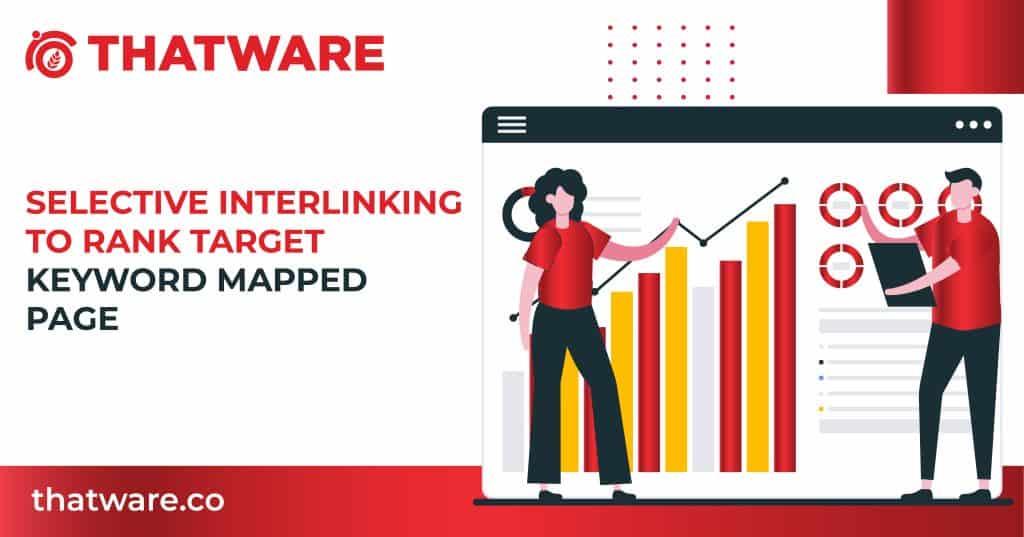Ranking your mapped page for a target keyword is tough. If you have any practical SEO experience you might have noticed, that in many cases, the page that does rank for our target keyword isn’t always the intended page.

Even if the intended page does rank we often have to deal with cannibalization issues and then resolving that is whole another story.
In this blog, we have come up with a strategy by which we can rank target pages for specific keywords by selectively interlinking.
But before that let’s understand how ranking is determined by Page Rank.
What is Page Rank?
PageRank refers to the system and the algorithmic method that Google uses to rank pages as well as the numerical value assigned to pages as a score.
Understanding Interlinking and Its Impact on SEO
Interlinking, also known as internal linking, is a fundamental aspect of search engine optimization (SEO) that plays a significant role in improving website visibility, user experience, and search engine rankings. In this section, we’ll delve into the definition, significance, types, and strategies of interlinking, as well as its impact on SEO efforts.
A. Definition and Significance of Interlinking
Interlinking refers to the practice of linking one webpage to another within the same website. These internal links serve as pathways that connect different pages, guiding users and search engine crawlers to navigate through the website’s content more efficiently. Interlinking is significant for several reasons:
- Enhanced User Experience: By providing internal links, website visitors can easily explore related content and navigate between pages, leading to a more seamless and intuitive browsing experience.
- Improved Website Structure: Interlinking helps to establish a hierarchical structure within the website, organizing content into logical categories and subcategories. This improves website navigation and accessibility for both users and search engines.
- Distributed Page Authority: Internal links distribute page authority and link equity throughout the website, helping to strengthen the overall authority and relevance of individual pages and the website as a whole.
- Facilitates Indexing and Crawling: Internal links provide pathways for search engine crawlers to discover and index new content on the website. This ensures that all relevant pages are properly crawled, indexed, and included in search engine results.
B. How Interlinking Contributes to SEO Efforts
Interlinking plays a crucial role in supporting various SEO efforts and strategies, contributing to improved search engine rankings, organic traffic, and website visibility. Here’s how interlinking impacts SEO:
- Enhanced Crawling and Indexing: Internal links facilitate the crawling and indexing of web pages by search engine bots, ensuring that all content is discovered and included in search engine results.
- Keyword Relevance and Optimization: By using relevant anchor text in internal links, webmasters can optimize pages for specific keywords or phrases, signaling to search engines the relevance and context of the linked content.
- Page Authority and Link Equity Distribution: Internal links help to distribute page authority and link equity throughout the website, strengthening the authority and relevance of individual pages and improving overall search engine rankings.
- Reduced Bounce Rate: Well-placed internal links can encourage visitors to explore additional content on the website, reducing bounce rates and increasing user engagement and session duration.
C. Types of Interlinking: Navigational, Contextual, and Deep Interlinking
Interlinking can take various forms, each serving a specific purpose and contributing to overall SEO efforts. Some common types of interlinking include:
- Navigational Interlinking: Navigational interlinking involves linking to key pages within the website’s navigation menu or sidebar. These links provide users with easy access to important sections of the website, such as the homepage, product pages, or contact information.
- Contextual Interlinking: Contextual interlinking involves embedding links within the body of content, typically within blog posts, articles, or other written content. These links are used to reference related or relevant content within the website, providing additional information or context for readers.
- Deep Interlinking: Deep interlinking involves linking to pages that are deeper within the website’s hierarchy, such as category pages, product pages, or archived content. These links help distribute authority throughout the website and ensure that all pages are indexed and accessible to search engines.
D. The Role of Anchor Text in Interlinking Strategies
Anchor text, or the clickable text of a hyperlink, plays a crucial role in interlinking strategies and SEO optimization. When used strategically, anchor text can provide context and relevance to linked pages, helping search engines understand the content and purpose of the link. Some key considerations for anchor text optimization include:
- Relevance: Anchor text should accurately reflect the content of the linked page and the context in which it is used. It should provide users with a clear indication of what to expect when they click on the link.
- Keyword Optimization: Where appropriate, anchor text can be optimized with relevant keywords or phrases that reflect the topic or theme of the linked page. This helps reinforce the relevance of the linked page to search engines and can improve its chances of ranking for related search queries.
- Variety: It’s important to vary anchor text throughout the website to avoid over-optimization and ensure a natural, user-friendly experience. This includes using a mix of branded anchors, generic anchors, and keyword-rich anchors to provide a diverse linking profile.
By understanding the significance of interlinking, the different types of interlinking strategies available, and the role of anchor text in optimization, website owners can leverage internal linking effectively to enhance SEO efforts and improve search engine rankings. Through strategic interlinking, websites can achieve greater visibility, authority, and relevance within their niche, ultimately driving more organic traffic and engagement.
How does Page Rank pass through Interlinking
The picture on the Moz Blog puts it very clearly.
Source: Moz Blog
The diagram shows that PageRank, a traditional model of how links move through web pages, no longer functions as it once did. The toolbar is a terrible predictor of PR flow, and even while Google (and other engines) may still employ some elements of the PR model (and related algorithms), it is unquestionably not the be-all and end-all of linking strategies.
However Links from Internal pages still pass Link Value, and the more the PR of a page, the more its probability to rank. We will use this concept in our attempt to rank a single page above all others.
How to Selectively Interlink Pages to Pass Page Rank Strategically
Identify the Target Keyword and all Pages containing it
The best way to do it is to simply put a site: command along with the target keyword.
In this example, we want to find out all pages in the domain aifpms.com containing the word “portfolio managers”.
Scrap all Page URLs containing the Target Keyword
You can scrap the urls from Google SERP itself using the Scraper extension. The following video from Ahrefs will tell how to use it. (Watch from 2:34 sec timestamp)
<iframe width=”853″ height=”480″ src=”https://www.youtube.com/embed/8f4YTubL6cM?list=PLvJ_dXFSpd2tjUTuAHpHidz5e2hAedP_m” title=”How to Build Unique Backlinks With Resource Page Link Building” frameborder=”0″ allow=”accelerometer; autoplay; clipboard-write; encrypted-media; gyroscope; picture-in-picture” allowfullscreen></iframe>
Save the scraped page urls in an Excel Sheet.
Find all Page Ranks using Gephi
To know how to use Gephi, you can read our Definitive Guide or you can watch the video I made to find all relative page ranks values for your pages.
Video Link > https://drive.google.com/file/d/1bxnz6qW-9JGQ-7qOIGbZd0N9WD1S5DHl/view?usp=sharing
After you have exported all the website page URLs with the page ranks, you can find the page ranks of the previously exported urls containing the keyword “portfolio manager” specifically using a simple VLOOKup function.
If you don’t know how to use a VLOOKup function you can refer to the following video.
<iframe width=”853″ height=”480″ src=”https://www.youtube.com/embed/Lw03WcG4mt4″ title=”Vlookup Function in Excel for Beginners” frameborder=”0″ allow=”accelerometer; autoplay; clipboard-write; encrypted-media; gyroscope; picture-in-picture” allowfullscreen></iframe>
Filter Pages with a Page Rank lower than the Target URL
Essentially the concept is we want to make sure all relevant pages with a page rank lower than the target page links to the target page to empower it.
We are not to touch the page with the highest page rank since we don’t want to disturb their rankings.
The rest you can sort out in the Excel File.
Final Thoughts
This strategy is one of the most effective ways to rank specific landing pages in Google SERP. Eventually, by repeating the cycle every 3-4 months, we eventually make sure all our pages are properly linked and our most important pages have proper link and page rank distribution.


